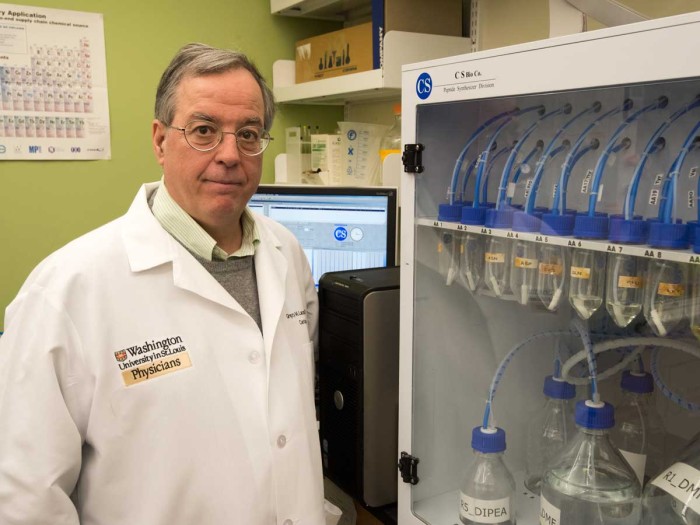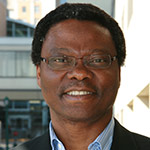Scientists receive $13.7 million to develop new multiple myeloma treatments
New center will focus on developing nanomaterials and drugs to treat this cancer of the immune system

Gregory Lanza, MD, PhD, is co-director of the Center for Multiple Myeloma Nanotherapy at Washington University. He and other researchers at the center have been awarded $13.7 million to develop new treatments for multiple myeloma, a cancer of the immune system. <em>Photo: Robert Boston</em>
Researchers at Washington University School of Medicine in St. Louis have been awarded $13.7 million from the National Cancer Institute (NCI) to create new therapies for multiple myeloma, a cancer of immune cells in the bone marrow.
Led by Samuel Achilefu, PhD, and Gregory Lanza, MD, PhD, at the university’s newly created Center for Multiple Myeloma Nanotherapy, scientists will work to develop nanomaterials and drugs to treat the disease, which kills most patients within six years of diagnosis.
“Patients with multiple myeloma often respond well to initial treatment,” said Achilefu, the center’s director and a professor of radiology at the School of Medicine. “Unfortunately, nearly all relapse. We’re focused on improving patient outcomes by developing and moving promising new therapies from the lab to the clinic.”
Lanza, the Oliver M. Langenberg Distinguished Professor of Science and Practice of Medicine at the School of Medicine, is the center’s co-director. Two others also will help lead critical projects at the center: John DiPersio, MD, PhD, the Virginia E. and Sam J. Golman Professor of Medicine, and Michael Tomasson, MD, a professor of medicine. They and Achilefu are affiliated with Siteman Cancer Center at Barnes-Jewish Hospital and Washington University School of Medicine.

This year, an estimated 26,850 U.S. residents will be diagnosed with multiple myeloma, and about 11,240 patients are expected to die, according to the American Cancer Society.
The center’s three primary goals are:
- To develop new drugs and nanodelivery methods. Lanza will work with Tomasson on a nanoparticle-based therapy that already has proven effective in treating mice with multiple myeloma. Targeted specifically to malignant cells, these nanoparticles protect their therapeutic cargo from degradation in the bloodstream and greatly enhance drug delivery into the cancer cells. These are longtime hurdles in the development of this class of potential cancer drugs.
- To develop a therapy that uses a combination of light and a photosensitizing drug to kill cancer cells. Achilefu leads this project with Pratim Biswas, PhD, the Lucy & Stanley Lopata Professor and head of the Department of Energy, Environmental & Chemical Engineering at Washington University, and, Katherine Weilbaecher, MD, a professor of medicine. They will use radiopharmaceuticals to create a light source within the tumor cells. Such light will stimulate the photosensitizers in cancer cells, converting them into highly toxic drugs. By selectively triggering therapy inside cancer cells, Achilefu hopes to minimize the toxic effects of drugs to healthy tissue.
- To understand the molecular basis of these therapies to mediate drug resistance and progression of multiple myeloma. DiPersio leads this project.
Leading scientific support services for the center are: Kooresh Shoghi, PhD, an associate professor of radiology, who will oversee the Imaging Biomarker Quantification and Standardization Core, and Fred Prior, PhD, an adjunct professor of radiology at Washington University and chair of the Department of Biomedical Informatics at the University of Arkansas for Medical Science College of Medicine, who will lead the Data Management Core.
Larry J. Shapiro, MD, who recently stepped down as executive vice chancellor for medical affairs and dean of the School of Medicine, said the multiple myeloma center capitalizes on a number of strengths. “This represents the best of what Washington University is – a group of talented people committed to excellence, working in an environment that fosters innovation,” he said.
The center is one of six Centers of Cancer Nanotechnology Excellence supported by the NCI of the National Institutes of Health (NIH). The others are overseen by the California Institute of Technology and University of California, Los Angeles; Memorial Sloan Kettering Cancer Center and Cornell University; Northwestern University; Stanford University; and the University of North Carolina at Chapel Hill.






